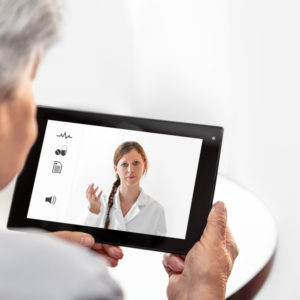Telemedicine challenges the established order of medical licensure in the United States. Medical treatment with a physician in one place and a patient in another raises questions about the efficiency and constitutionality of state-by-state licensure.
Generally, a physician can only practice medicine in states where he or she holds a medical license, regardless of whether the doctor and patient are meeting in person or via electronic means (video conferencing, remote monitoring, online prescriptions, asynchronous consultation, email, or telephone conversations). Some states have partially lowered state-line barriers via mechanisms like the Interstate Medical Licensure Compact.
Fragmentary licensing makes it difficult for telemedicine providers to serve the entire country. A recent CNBC article said that a doctor who wished to practice telemedicine across the entire United States would have to spend around $90,000 and countless hours to obtain licenses in every state—followed by permanent efforts to maintain the licenses.
To minimize queuing and capture economies of scale, it’s important for telemedicine providers to have broad, multistate reach. If I take ill at night while a flu epidemic rages here in Virginia, I might have difficulty reaching an overburdened Virginia telemedicine doctor. But, with access to doctors in all 50 states, there’s a far better chance that I’ll get rapid, potentially lifesaving service. State-by-state licensing inhibits this capability. Presumably, nationwide reach also increases competition, with the potential for cost reduction and quality improvement.
I live in Virginia, and it’s perfectly fine for me to visit a doctor in Texas. However, if I wished to consult with the same doctor via video link from Virginia, the doctor would presumably require a Virginia license as well as a Texas license. Present-day law somewhat arbitrarily presumes that an encounter occurs where the patient sits—not where the doctor sits.
And suppose I engage with the Texas doctor while I’m visiting Florida and the doctor is in Hawaii? Is our encounter deemed to occur in Virginia, Texas, Florida, or Hawaii? Perhaps there’s a simple legal answer, but I’ve raised the question before enough audiences to think the answer isn’t crystal-clear.
Telemedicine adds a powerful new element to America’s health care system. It provides near-instantaneous access to care from any location, at any time, on any day. Cost-benefit analysis requires us to ask how often state-by-state licensing prevents, delays, or heightens the cost of care, along with asking whether state-by-state licensing somehow protects patients better than, say, a regime of national licensing.
This matters, because telemedicine increases access to care in ways that were unimaginable before the digital era. Imagine a Spanish-speaking migrant family whose child becomes ill on a remote ranch in the middle of the night. With telemedicine, a cellphone allows them to reach a Spanish-speaking doctor within minutes. Think of the access challenges faced by members of other linguistic minorities, Native Americans on reservations, people with mobility problems, people in neighborhoods lacking public transportation, those busy with work and childrearing, and individuals who take ill at odd hours and in isolated places.
I once wrote about a physician who saved a woman’s life because she was able to call him at night from her home, rather than waiting for a regular in-person appointment. At age 92, my own mother likely survived a potentially fatal illness because her grandson, a physician, recognized her illness in the course of a social video call on FaceTime. Ever since, I’ve thought that one shouldn’t require a physician in the family to enjoy such care.
When state-by-state medical licensing was devised, these weren’t issues. If you saw a doctor, you were face-to-face in the same state. Telephone calls or mail would likely have been the only potential exceptions. But today, sophisticated communication at a distance is omnipresent in our lives.
There is virtue in the principle of allowing states to manage economic activity within their individual boundaries—“laboratories of democracy,” in the words of Justice Louis Brandeis. But there is also virtue in erasing those lines for some purposes, a principle enshrined in the Constitution’s interstate commerce clause. Philosophically, I grapple with the tension between these two principles. I also wonder whether that tension may ultimately find its resolution at the Supreme Court.

